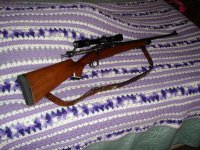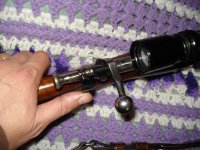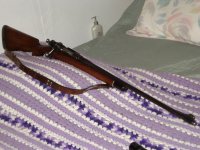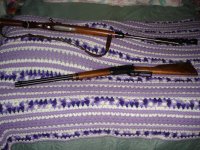The safety looks like an aftermarket 'low 'scope safety' probably added at the time the rifle was sporterized from it's military configuration.
The military safety works as Cyrano explained,,and a 'scope is right in the way of it.
The 'low scope safety' was a simple aftermarket part that replaced the military safety and allowed the safety to work w/a scope in place.
Buehler, Williams, Timney, Pacific and others all made low scope safetys for just about every model of military rifle around. Yours might be marked with a mfg marking
They function differently from the military unit in that they flip up from the right side to about the 1 oclock position to place the rifle at SAFE. Then press down on the thumb piece,,it'll click down to about the 5 oclock position. At that point the rifle is in the FIRE position.
The bolt handle is also altered from it's military form,,again to allow the scope to be mounted. If left undone, the bolt handle would hit the scope tube upon opening the action.
The handle was/is sometimes forged to a concave curve to give clearance. Sometimes a new handle is welded onto the bolt body after the original is cut off.
Looks like who ever did the work may have opted to just cut some clearance in the original handle sweep and angle for the scope. Not unusual either.
These Remington 1903's made during WW2 have always been considered kind of a 'why bother to put the work into them' type of rifle by the custom rifle builders. Yes the early Springfield '03s hold the snob appeal and they are quality built rifles. A few mfg short cuts on the WW2 guns, more tool marks, maybe looser specs, ect.
But they are fine rifles and will do everything needed in the field.
Check and make sure the scope mts and rings are secure. Check the front and back guard screws and make sure they are tight.
A check of the headspace wouldn't be a bad idea if you have access to it. If not, carefully inspect the fired cases for backed out primers, ect.
Other than that take it out and have fun with it.
 . It has a scope and a stock way different than any pictures I can find online. The bolt is complicated to me, I had to take it apart to get it to not hang up going forward and am unsure of how that works. I have it moving very smooth now but am unsure of how to properly operate the rear spring loaded part. I am used to handguns and lever action rifles and this thing stumps me and my friend. Any help on info of any kind?
. It has a scope and a stock way different than any pictures I can find online. The bolt is complicated to me, I had to take it apart to get it to not hang up going forward and am unsure of how that works. I have it moving very smooth now but am unsure of how to properly operate the rear spring loaded part. I am used to handguns and lever action rifles and this thing stumps me and my friend. Any help on info of any kind?




